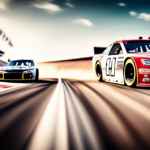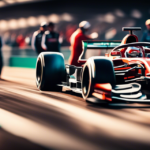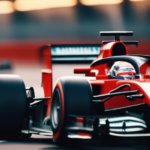NASCAR: Unveiling the Top 5 Most Important Factors for Picking Winners
Factor 1: Track Type and Layout
Now that we’ve got the engines revving and the tires screeching, it’s time to dive into the first critical factor for picking winners in NASCAR: track type and layout. Believe me when I say, this one can make all the difference between a triumphant victory and a face full of asphalt.
Picture this: you’re at the racetrack, the sun beating down on your well-worn cap, and you’re pondering which driver to place your hard-earned money on. Well, my friends, you better listen up, because if you overlook the track type and layout, you might as well be betting on a turtle in a speed competition.
NASCAR is all about building up that rhythm and maintaining consistency. A driver who has consistently performed well in recent races is likely to continue their winning streak. On the flip side, keep an eye out for any drivers or teams going through a rough patch because that could impact their performance in the upcoming race.
Now, let me break it down for you. NASCAR encompasses a wide range of tracks, each with its own unique characteristics. We’ve got the superspeedways like Daytona and Talladega, where speed reigns supreme and drafting becomes an art form. Then, there are the short tracks like Bristol and Martinsville, where bumping and grinding are practically mandatory. And let’s not forget about the intermediate tracks, a happy medium between pure speed and tight turns.
Different drivers excel in different environments, just like hockey players have their favorite rinks to dominate. Some drivers thrive on the high banks of Daytona, mastering the art of the slingshot pass, while others prefer the finesse required to navigate tight corners on the short tracks. And let’s not overlook the drivers who consistently deliver on the intermediate tracks, showcasing their well-rounded skills.
Consider a driver’s history at similar tracks and how well they adapt to the particular challenges presented. This will give you a good indication of who’s likely to rule the asphalt and who’s better off watching from the sidelines, nursing their bruises.
But hey, don’t just take my word for it. Let me share a story to illustrate the point. One time, I was watching a race at Talladega, and this underdog driver, let’s call him Lightning Larry, had an impressive track record at superspeedways. The odds were stacked against him, but I trusted my gut and placed my bet on Lightning Larry. And wouldn’t you know it, he streaked past his competitors and claimed victory, leaving me with a grin wider than the track itself.
So remember, my dear friends, track type and layout matter—a lot. Study the tracks, analyze the drivers’ performances, and make an informed choice. And always keep in mind that sometimes, the unexpected, like Lightning Larry’s lightning-fast speeds, can lead to the biggest wins of all.
Fasctor 2: Skill on Various Track Types:
NASCAR is diverse when it comes to the types of tracks on the circuit. You’ve got superspeedways, intermediate tracks, road courses, and short tracks, just to name a few. Each track demands different skill sets from the drivers. Some excel on superspeedways with their ability to maintain high speeds and navigate through chaotic pack racing, while others thrive on road courses, showcasing their finesse in turning left and right. Understanding a driver’s strengths and weaknesses on different track types is crucial in making accurate predictions.
Consistency and Adaptability:
Consistency is key in NASCAR. Drivers who consistently perform well throughout the season have a higher chance of delivering strong results. Look for drivers who consistently finish in the top positions and display a solid ability to adapt to varying track conditions. The ability to adjust the car’s setup based on changing track temperatures, tire wear, and other factors is a testament to a driver’s experience and skill.
Previous Performance at the Track:
Past performance can provide valuable insights into a driver’s potential success at a particular track. Take a look at a driver’s history at a specific venue. Did they win there before? How many top finishes have they achieved? If a driver has a strong track record at a particular circuit, it’s a good indication that they have a solid understanding of the track’s nuances and can capitalize on that knowledge.
Experience in High-Stakes Races:
NASCAR has its fair share of marquee events, such as the Daytona 500 and the Brickyard 400. These high-stakes races demand nerves of steel and the ability to handle immense pressure. Drivers who have proven themselves in these prestigious races have shown that they can thrive in intense environments. Keep an eye on drivers who have a track record of success in these highly anticipated events.
Team Chemistry and Communication:
NASCAR, like any other sport, is a team effort. The relationship between the driver and their crew chief plays a crucial role in achieving success. A strong rapport between the driver and the crew chief, effective communication, and a well-coordinated team effort can give a driver an edge on the track. Pay attention to drivers who have established solid relationships with their teams and have consistent communication during the race.
With Factor 2 in mind, we’ve explored the world of driver ability and experience. This isn’t just about being fast, folks—it’s about skill, consistency, adaptability, and the ability to perform under pressure. So, as you embark on your NASCAR betting journey, keep these factors in mind. And always remember, picking winners is an art backed by expertise and a little sprinkle of good luck.
Factor 3: Car Performance and Speed:
If you want to pick winners in NASCAR, you better pay attention to this key factor. Trust me, it’s not just about the driver and the track—it’s all about the machine they’re in.
1. Engine Power: The heart of any race car is its engine, and when it comes to NASCAR, the power under the hood is absolutely paramount. You need to consider factors such as horsepower, torque, and advanced engine technologies. High-performance engines give drivers that extra edge on the track, allowing them to unleash their full potential. Keep an eye on the teams that invest in top-notch engine development and are known for producing brute power.
2. Aerodynamics: When those cars are zooming around the track at breakneck speeds, aerodynamics play a crucial role. The shape and design of the car can make a substantial difference in minimizing drag and maximizing downforce. Teams that excel in wind tunnel testing and improve their aerodynamics have a significant advantage, especially on tracks where speed is everything. Remember, even the smallest adjustments in aerodynamics can result in critical improvements in performance.
3. Tire Management: Tires are the only connection between the car and the track, making them a vital aspect of car performance. Understanding tire behavior, how they handle wear and heat, and the ability to manage tire strategy throughout the race can make or break a team’s chances of victory. Some drivers are exceptional at preserving tire life and finding the right balance between speed and conservation. Pay attention to those who consistently exhibit skillful tire management.
4. Mechanical Grip: The ability of a race car to maintain traction and grip on the track is essential for optimal speed and control. Factors such as suspension setup, chassis stiffness, and weight distribution come into play when considering mechanical grip. A well-tuned car that can hug the corners and maintain stability even under high speeds is worth its weight in gold. Look for teams that have a solid understanding of mechanical grip and can adapt to different track conditions.
5. Pit Crew Efficiency: Car performance is not solely reliant on the car itself but also on the efficiency and expertise of the pit crew. A well-drilled crew can execute lightning-fast tire changes, refueling, and make necessary adjustments to the car in a matter of seconds. Pit stops are where races can be won or lost, so keep an eye on teams with highly skilled and quick-thinking crew members.
When it comes to car performance and speed, it’s not just about raw power—it’s about finding the perfect balance between power, aerodynamics, tire management, mechanical grip, and a stellar pit crew. It’s the synergy of these elements that separates the contenders from the pretenders in the exhilarating world of NASCAR.
Factor 4: Team Strategy and Pit Stops
We’ve covered the importance of track type, the skills of the drivers, and the speed demons behind the wheel. But let’s not forget about the crucial factor of team strategy and those pit stops that can make or break a race. Get ready for some insider knowledge, because we’re diving into the world behind the scenes!
You see, NASCAR racing isn’t just about the drivers and their cars. It’s a symphony, an orchestrated dance between driver and team. The decisions made on pit road can have a massive impact on the outcome of the race. So, let’s take a look at why team strategy and pit stops matter so much.
First off, pit stops are where lightning-fast work happens. These are the moments when cars come in for tire changes, fuel refills, and repairs. The skill and efficiency of the pit crew can make the difference between gaining precious seconds or losing valuable positions on the track. As a bettor, you need to understand how different teams perform in the pits. Are they known for lightning-fast tire changes, or do they tend to fumble and lose precious time? Knowing this can give you a significant edge when placing your bets.
But it’s not just the speed of pit stops that matters; it’s also the strategic decisions made by the team. Pit stops are opportunities for teams to adjust their strategies, make crucial changes, and gain an advantage over their rivals. This can involve altering tire pressures, adjusting the car’s aerodynamics, or even opting for a risky fuel strategy. The teams that master the art of strategic pit stops can turn the tide in their favor and steal victories from under the noses of their competitors.
As a sports bettor, it’s crucial to keep an eye on the teams with a history of smart, strategic decisions. Look for those crews that consistently make the right calls during pit stops and adapt to changing track conditions. It’s not just about their speed; it’s about their ability to think on their feet and make split-second decisions that can make their driver a force to be reckoned with.
Now, of course, there’s always an element of unpredictability in any sport. Pit stops can bring unexpected challenges – a dropped lug nut, a malfunctioning fuel pump, or even a minor slip-up by a crew member. But that’s what makes NASCAR racing so thrilling. Even with the best strategy and a well-oiled pit crew, anything can happen, and it’s the ability to adapt and overcome that the champions from the rest.
So, my fellow bettors, when you assess the potential winners of a NASCAR race, don’t forget to consider the team strategy and pit stop performance. Identify those crews with a track record of lightning-fast stops and smart decision-making. They may just hold the key to unlocking the secret to your betting success.
Factor 5: Race History and Recent Performance
We’re rounding the last turn of our NASCAR knowledge journey, and we’re about to tackle the final factor for picking winners – race history and recent performance. This one’s a doozy because it requires a keen eye for the previous races and the momentum of the drivers and teams.
You see, NASCAR is all about building up that rhythm and maintaining consistency. A driver who has consistently performed well in recent races is likely to continue their winning streak. On the flip side, keep an eye out for any drivers or teams going through a rough patch because that could impact their performance in the upcoming race.
When considering race history and recent performance, it’s important to analyze the specific race type and track. Some drivers excel on certain tracks, while others struggle. If you spot a driver who consistently performs well on a particular track, take note because history tends to repeat itself in NASCAR.
Additionally, keep an eye on how the team performs as a whole. A driver is only as good as the team supporting them. If there’s friction within the team, issues with pit stops, or a lack of coordination, it can significantly impact the race outcome. Pay attention to any changes in the team structure or conflicts that may affect their overall performance.
Now, I’m not saying you should base your bets solely on race history and recent performance. Remember, it’s the combination of all these factors that gives us that edge in sports betting. But having a good grasp of a driver’s recent form and their team’s dynamics can certainly give you a leg up in making smart betting decisions.
We’ve delved into the thrilling world of NASCAR and explored the top 5 most important factors for picking winners. Remember, sports betting is not just about blind luck; it’s about strategy, knowledge, and a whole lot of fun! With a little bit of research and an understanding of these key factors, you’ll set yourself up for success on the race track.
But before you dive headfirst into the adrenaline-fueled world of NASCAR betting, let me leave you with a few final words of encouragement. Rome wasn’t built in a day, and becoming a master sports bettor takes time, dedication, and a whole lot of patience. Don’t get discouraged by a few bumps in the road; treat them as valuable lessons and fuel for improvement.
Until next time, this is Grant, signing off.
Happy betting, folks!
- Grant
Additional Studies:
- Learn Advanced Bankroll Management
 Sports betting can be unpredictable, just like life. You never know when a favorite horse might pull up lame or when the underdog team might pull off a stunning upset.
Sports betting can be unpredictable, just like life. You never know when a favorite horse might pull up lame or when the underdog team might pull off a stunning upset. - NASCAR: Tracks and Features
 You may think that NASCAR is simply about cars zooming around ovals, but it’s so much more than that. Each track has its own unique characteristics and features that pose different challenges to drivers, making every race a thrilling, edge-of-your-seat experience.
You may think that NASCAR is simply about cars zooming around ovals, but it’s so much more than that. Each track has its own unique characteristics and features that pose different challenges to drivers, making every race a thrilling, edge-of-your-seat experience. - Formula 1: The Tracks and Features
 Prepare to dive headfirst into the exhilarating world of Formula 1 racing, where speed, precision, and sheer adrenaline take center stage.
Prepare to dive headfirst into the exhilarating world of Formula 1 racing, where speed, precision, and sheer adrenaline take center stage. - Betting on Formula One Racing: A Beginners Guide
 We’re about to embark on a Formula One journey that will leave you ready to outsmart the odds, make informed decisions, and hopefully, cash in some sweet victories.
We’re about to embark on a Formula One journey that will leave you ready to outsmart the odds, make informed decisions, and hopefully, cash in some sweet victories. - How to Pick the Winner in Formula 1 Racing
 Get ready to uncover the hidden tricks and tips that could turn you into a master of picking the winning drivers. In Formula 1, it’s all about speed, precision, and strategy.
Get ready to uncover the hidden tricks and tips that could turn you into a master of picking the winning drivers. In Formula 1, it’s all about speed, precision, and strategy.
